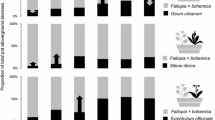Abstract
Allelopathy is a notoriously difficult mechanism to demonstrate. There has been a recent resurgence of interest in allelopathy because of the work done on the invasive weed spotted knapweed and its putative allelochemical, (±)-catechin. In this study we collected and analyzed soil samples taken from three, long-term knapweed infested sites in Montana, USA during the summer and fall of 2005. We only detected catechin in all the soil cores at one time point (August, 2005) at two of the sites. Field levels from these two sites were nearly three orders of magnitude lower than what has previously been reported to cause reduced growth in a sensitive native species. Fourteen percent of the remaining soil cores contained low but detectable levels (<0.11 ppm) of (±)-catechin. Additional experiments indicated that soil moisture appears to play a significant role in whether or not catechin degrades rapidly or remains in the soil. Adding to previous work, this paper sheds doubt on the importance of this chemical in spotted knapweed invasion success.
Similar content being viewed by others
References
Bais, H. P., Walker, T. S., Stermitz, F. R., Hufbauer, R. A., and Vivanco, J. M. 2002. Enantiomeric-dependent phytotoxic and antimicrobial activity of (±)- catechin. A rhizosecreted racemic mixture from spotted knapweed (Centaurea maculosa). Plant Physiol. 128:1173–1179.
Bais, H. P., Vepachedu, R., Gilroy, S., Callaway, R. M., and Vivanco, J. M. 2003. Allelopathy and exotic plant invasion: from molecules and genes to species interactions. Science 301:1377–1380.
Blair, A. C., Hanson, B. D., Brunk, G. R., Marrs, R. A., Westra, P., Nissen, S. J., and Hufbauer, R. A. 2005. New techniques and findings in the study of a candidate allelochemical implicated in invasion success. Ecol. Lett. 8:1039–1047.
Callaway, R. M. and Ridenour, W. M. 2004. Novel weapons: invasive success and the evolution of increased competitive ability. Front Ecol. Environ. 2:436–443.
Harper, J. L. 1977. Population Biology of Plants. Academic, London.
Ochsmann, J. 2000. Morphologische and molekularsystematische untersuchungen an der Centaurea stoebe L.-Gruppe (Asteraceae–Cardueae) in Europa. Diss. Bot. 324:242.
Perry, L. G., Thelen, G. C., Ridenour, W. M., Weir, T. L., Callaway, R. M., Paschke, M. W., and Vivanco, J. M. 2005. Dual role for an allelochemical: (±)-catechin from Centaurea maculosa root exudates regulates conspecific seedling establishment. J. Ecol. 93:1126–1135.
Roché, B. F. and Roché, C. T. 1991. Identification, introduction, distribution, and economics of Centaurea species, pp. 274–291, in L. F. James, J. O. Evans, M. H. Ralphs, and R. D. Child (eds.). Noxious Range Weeds. Westview, San Francisco, California.
Romeo, J. T. 2000. Raising the beam: moving beyond phytotoxicity. J. Chem. Ecol. 26:2011–2014.
Thelen, G. C., Vivanco, J. M., Newingham, B., Good, W., Bais, H. P., Landres, P., Caesar, A., and Callaway, R. M. 2005. Insect herbivory stimulates allelopathic exudation by an invasive plant and the suppression of natives. Ecol. Lett. 8:209–217.
Weir, T. L., Bais, H. P., and Vivanco, J. M. 2003. Intraspecific and interspecific interactions mediated by a phytotoxin, (−)-catechin, secreted by the roots of Centaurea maculosa (spotted knapweed). J. Chem. Ecol. 29:2397–2412.
Acknowledgment
We would like to thank Celestine Duncan for collecting the soil samples.
Author information
Authors and Affiliations
Corresponding author
Rights and permissions
About this article
Cite this article
Blair, A.C., Nissen, S.J., Brunk, G.R. et al. A Lack of Evidence for an Ecological Role of the Putative Allelochemical (±)-Catechin in Spotted Knapweed Invasion Success. J Chem Ecol 32, 2327–2331 (2006). https://doi.org/10.1007/s10886-006-9168-y
Published:
Issue Date:
DOI: https://doi.org/10.1007/s10886-006-9168-y




